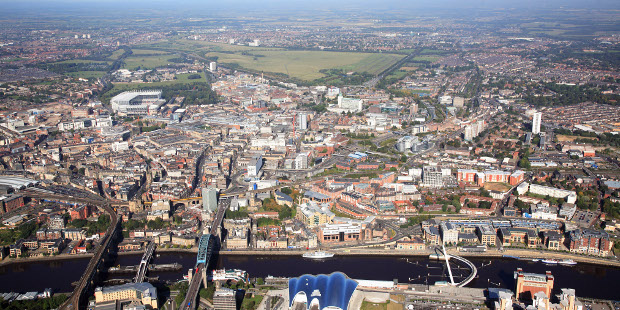
Newcastle transition to a Green City Presentation
The above presentation pulls together some thoughts on creating a ‘green city’ vision for Newcastle upon Tyne in the NE of England. A PDF version is appended.
In 2010, Newcastle did win the ‘top green city’ award from the ‘Forum for the Future’ consortium. Actually, the result was very misleading. The city has the windfall of a big open space called the Town Moor, near the city centre, something rare if not unique in the UK (the green area in the top middle of the picture above). This skewed the result in Newcastle’s favour (and, in reality, the Town Moor is far from green in terms of ecological richness and diversity).
In fact, the city is very far from green in any meaningful sense (see: https://sandyirvineblog.wordpress.com/2019/04/12/green-what-does-it-mean-presentations/). It was named by the ‘Sunday Times’ for example as ‘tree-felling’ capital of England. It has been threatened with legal action because of air pollution in the city. The council has perpetrated the biggest grab of green belt land in the country, all for the sake of sprawling car-dependent ‘executive housing’ dormitory suburbs on the edge of town.
In many areas, there are empty shops, offices and housing. Indeed much of the housing stock is in very poor condition and many people do not have health-promoting parks and other green space nearby. Meanwhile, the local airport, with council backing, is seeking to expand air flights, despite the unsustainable damage it does. Action to encourage cycling and walking has been fitful while plans for big new roads keep rearing their ugly head (as in the case of the ‘Blue House’ roundabout and the expansion of the western bypass).
This presentation focuses on an alternative vision for a city that is sustainable and ‘future-proof’ in this age of rapidly worsening climate breakdown and other forms of ecological meltdown. Action on all those fronts actually provides many opportunities to build a much fairer, more inclusive, and indeed more convivial community in Newcastle. But it will mean abandoning all the growth fantasies embodied in thje city’s development plan, the Core Stategy. We need a green plan for Newcastle and this presentation is a contribution to that end.
Later, detailed notes will be added in the form of a PDF. For some historical background, see: https://sandyirvineblog.wordpress.com/2019/03/16/changing-newcastle-1960s-2010s/
PDF version of presentation:
Newcastle transition to a Green City Presentation PDF


You must be logged in to post a comment.